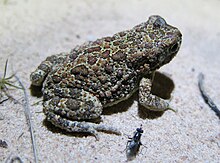
Bufo is a genus of true toads in the amphibian family Bufonidae. As traditionally defined, it was a wastebasket genus containing a large number of toads from much of the world, but following taxonomic reviews most of these have been moved to other genera, leaving only seventeen extant (living) species from Europe, northern Africa and Asia in this genus, including the well-known common toad. Some of the genera that contain species formerly placed in Bufo are Anaxyrus, Bufotes, Duttaphrynus, Epidalea and Rhinella.
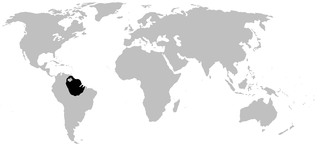
The Tukeit Hill frogs are three species of frog in the genus Allophryne. Originally erected for the species Allophryne ruthveni, the genus was placed as the only member of the subfamily Allophryninae, which was in turn placed in the family Centrolenidae, but they are now considered as the only genus in the monotypic family Allophrynidae.

The Arthroleptidae are a family of frogs found in sub-Saharan Africa. This group includes African treefrogs in the genus Leptopelis along with the terrestrial breeding squeakers Arthroleptis, and several genera restricted to the Guinean forests of central and west Africa, such as the hairy frog (Trichobatrachus).
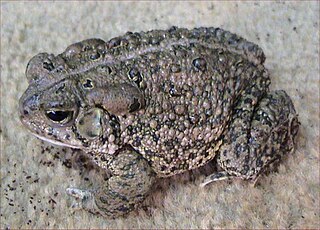
Woodhouse's toad is a medium-sized true toad native to the United States and Mexico. There are three recognized subspecies. A. woodhousii tends to hybridize with Anaxyrus americanus where their ranges overlap.

The Great Plains toad is a relatively large species of true toad native to central North America.

The marsupial frogs are a disputed family (Amphignathodontidae) in the order Anura. When treated as a separate family, it consists of two genera, Gastrotheca and Flectonotus. The frogs are native to Neotropical America. Under the dominant view, they are treated as part of the family of Hemiphractidae.

Duttaphrynus, named after Sushil Kumar Dutta, is a genus of true toads endemic to southwestern and southern China, Taiwan and throughout southern Asia from northern Pakistan and Nepal through India and Bangladesh to Sri Lanka, Andaman Island, Sumatra, Java, Borneo and Bali.

The Mongolian toad, also known commonly as the piebald toad or the Siberian sand toad, is a species of toad in the family Bufonidae. The species is endemic to northeastern Asia. It was formerly placed in the genus Bufo, then for a few years in Pseudepidalea until finally moved to its own genus Strauchbufo.
Poyntonophrynus kavangensis is a species of toad in the family Bufonidae. It is found in Angola, Botswana, Namibia, Zimbabwe, and presumably Zambia. Its natural habitats are sandy areas of grasslands. It is associated with ephemeral pools and pans. It can breed in hypersaline pans.

The raucous toad, also known as Ranger's toad, is a species of toad from Southern Africa.
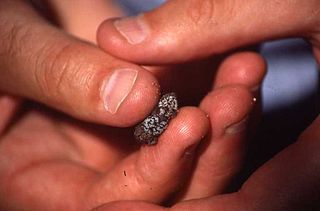
Mertensophryne is a genus of true toads. They are found in eastern and southern Democratic Republic of Congo to Kenya, Tanzania, Malawi, southeastern Zimbabwe, and adjacent Mozambique. Their common names include snouted frogs, Chirinda forest toads, and forest toads. The genus is named for Robert Mertens, German zoologist and herpetologist.

Ingerophrynus is a genus of true toads with 12 species. The genus is found in southern Yunnan and Southeast Asia; from Myanmar and Indochina to peninsular Thailand and Malaya, Sumatra, Borneo, Java, Nias Island, Sulawesi, and the Philippines. This genus was established after a major taxonomical revision of frogs in 2006.

Sclerophrys is a genus of "true toads", family Bufonidae, native to Africa and the southern Arabian Peninsula. Originally, all of these species were classified in the genus Bufo. The genus, originally named Amietophrynus, was split due to large enough taxonomic divergence. Ohler and Dubois showed in 2016 that Sclerophrys capensis Tschudi, 1838 is the same species as Bufo regularis rangeri Hewitt, 1935, the type species of Amietophrynus. Because the former name is older, the implication is that Amietophrynus is a junior synonym of Sclerophrys.

Anaxyrus is a genus of true toads in the family Bufonidae. The genus is endemic to North and Central America. Some authors consider Anaxyrus to be a subgenus within Bufo.
The Latin word Cranopsis has been used to name animal genera of frogs, mollusks and branchiopods. Cranopsis, was used for an anuran, and is a junior homonym of Cranopsis, for a mollusk; and Cranopsis, for a branchiopod. Cranopsis currently describes a mollusk genus in the family Fissurellidae.

Incilius is a genus of toads in the true toad family, Bufonidae. They are sometimes known as the Central American toads or Middle American toads and are found in southern USA, Mexico, Central America, and northern Pacific South America. They are an ecologically and biogeographically diverse group of toads, including micro-endemic species such as Incilius spiculatus that are restricted to undisturbed cloud forests, and widespread lowland species such as Incilius valliceps that predominantly occur in disturbed habitats.

Feihyla is a genus of frogs in the family Rhacophoridae, subfamily Rhacophorinae. They are found in southern China and Vietnam, and likely also in Laos. Its phylogenetic position is not yet fully resolved, but it is probably the sister taxon to Taruga, Polypedates, and Rhacophorus. Feihyla was originally erected to resolve polyphyly of Chirixalus by absorbing "Chirixalus palpebralis".
Nannophryne is a small genus of true toads, family Bufonidae, from South America. They are found in central Andean Peru south to southern Chile and adjacent Argentina.
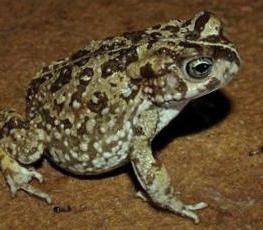
Vandijkophrynus, also known as Van Dijk's toads, are a small genus of true toads, family Bufonidae. They are native to Southern Africa. The name commemorates Eddie Van Dijk, a South African herpetologist.
Ronald Archie Nussbaum is an American herpetologist. He works with evolutionary biology and ecology of amphibians and reptiles, including systematics of caecilians and salamanders. He is a professor emeritus at the University of Michigan.
